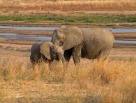Ruaha National Park
Many seasoned safarigoers rate Ruaha as the most rewarding of all East African game reserves. The country’s second-largest national park, it consists of 10,300 sq km of untrammelled semi-arid bush, and forms the core of the thrice-larger Greater Ruaha Ecosystem, a vast block of protected areas that supports one of the largest elephant populations on the continent
Set in the thinly inhabited heartland of central Tanzania, rugged and remote Ruaha has a mood all of its own, an almost spiritual quality embodied by the spectral baobab trees that stud its parched plains and boulder-strewn slopes. Complementing this evocative wilderness atmosphere, the park also offers some sterling game viewing – not only the ubiquitous elephants, but also an exceptional variety of antelope and other large ungulates, and some excellent big cat viewing.
Vegetation and habitats
- The park’s most significant geographic feature, the Great Ruaha River runs along the eastern boundary and is fed by seasonal tributaries such as the Jongomero, Mdonyo and Mwagusi sand rivers.
- A few rocky hills and escarpments notwithstanding, the predominant cover consists of semi-arid wooded savannah whose composition is transitional to the acacia-studded plains of the Serengeti-Mara and the miombo woodland belt of southern Africa
- Ruaha is famous for the ‘upside-down’ baobab trees whose bulbous silhouettes haunt its plains and slopes.
Wildlife
- Ruaha is one of the few African parks where casual visitors regularly encounter all three of Africa’s large cats – leopard, cheetah and prides of 20-plus lion, the latter capable of reducing a large male buffalo to a skeleton in a couple of hours.
- This is a good location for the endangered African wild dog, which is most often seen around the Mwagusi River.
- It is excellent elephant country too, with an estimated population of 12,000 centred upon the Greater Ruaha ecosystem.
- Thanks to its transitional location, Ruaha supports an unusually high variety of antelope. In addition to such usual suspects as impala, waterbuck and bushbuck, you’ll find Grant's gazelle and lesser kudu at the southern extent of their range, the miombo-associated sable and roan antelope, and the spectacular corkscrew-horned male greater kudu, which is most visible the breeding season (June).
- This transitional location is reflected in the birdlife, with central Tanzania endemics such as ashy starling and black-collared lovebird seen alongside southern species such as the colourful crested barbet, whose persistent trill is a characteristic sound of the park. The recently described Tanzania red-billed hornbill Tockus ruahae is more-or-less endemic to the park.






Activities
- Game drives are the main activity, and a good road network means you can go out several times without significantly retracing your steps.
- Several camps offer guided walks, with a very real chance of encountering the likes of lion and elephant on foot.
- The lodges all have good locations for birdwatching, with avian activity peaking in the pre-breakfast cool.
Getting there
- It’s best to visit during the dry season, May to November, as internal roads may be closed during the rains.
- Most visitors fly into Ruaha, using a daily scheduled flight to Dar es Salaam and Selous Game Reserve. There are also flights to Zanzibar, and charters to Mahale Mountains and Katavi National Parks are an increasingly popular option.
- Road access is via the district capital of Iringa, which is connected to Ruaha’s main entrance gate by a 120km dirt road that normally takes around 3 hours to cover in a 4x4. Iringa is 500km from Dar es Salaam on a fair surfaced road that usually requires 6-8 hours to cover. The drive from Dar es Salaam to Ruaha can thus be covered in one very long day, but could also be split up with an overnight stop in Mikumi National Park.
Where to stay
- Three fine luxury tented camps are situated within the park, respectively overlooking the seasonal Mwagusi and Jongomero Rivers and set in the old bed of the recently diverted Mdonyo River.
- An excellent 24-cottage midrange lodge stands alongside a hippo pool on the Ruaha River close to the main entrance gate.
- More affordable are the very basic prefabricated bandas at the Msembe park headquarters, where there is also a camping site.
- Outside the park, a number of moderately priced lodges are accessed from the Iringa road.
Nearby places of interest
- En route to Rauaha, the village of Kalenga houses a small museum dedicated to Chief Mkwawa of Uhehe, one of the key leaders of the resistance to German colonisation in the late 19th century.
- The Isimila Stone-Age Site near Iringa is worth visiting for its fossils of giant hippos and other extinct mammals, collection of prehistoric stone tools, and the spectacular sandstone formations carved by a defunct river.
Checklist of conspicuous and noteworthy mammals: lion, leopard, cheetah, side-striped jackal, African wild dog, spotted hyena, striped hyena, banded mongoose, white-tailed mongoose, blue wildebeest, common waterbuck, impala, greater kudu, common eland, sable antelope, roan antelope, bushbuck, common duiker, red duiker, African elephant, African buffalo, common zebra, hippo, warthog, Maasai giraffe, yellow baboon, vervet monkey, rock hyrax.
